IN THIS ISSUE
- Following another Georgia golden eagle
- 'Tis the season for spotting spotted turtles
- Our oldest oystercatcher and how it helps scientists
 Nesting bald eagles. (Curtis Compton/The Atlanta Journal-Constitution)
Quick quiz:
- What do taxes have in common with conserving bald eagles, gopher tortoises and other wildlife?
- What donation option for the Georgia Nongame Wildlife Conservation Fund takes less than 2 seconds but accounts for about 10 percent of contributions?
- How can filing your taxes help save rare animals, plants and natural habitats?
The answer to all of the above: the “Give Wildlife a Chance” state income tax checkoff.
In Georgia, the conservation of nongame wildlife - native animals not legally hunted or fished for - as well as rare plant species and their habitats is supported largely by the Nongame Wildlife Conservation Fund. This fund, set up by law for the work led by DNR’s Nongame Conservation Section, is sustained by public support.
The checkoff provided 9 percent of that support in fiscal year 2015.
Last question: What can you do?
When filling out income tax forms for 2015, don’t consider them finished until you fill in the Georgia Nongame Wildlife Conservation Fund checkoff, line 26 on the long form (Form 500) and line 10 on the short form (500EZ).
All donations, large or small, help.
FOR MORE
- Online
- Phone: Nongame Conservation Section offices in Social Circle (770-761-3035), Forsyth (478-994-1438) or Brunswick (912-264-7218).
- Tax forms and e-filing
Back to top.
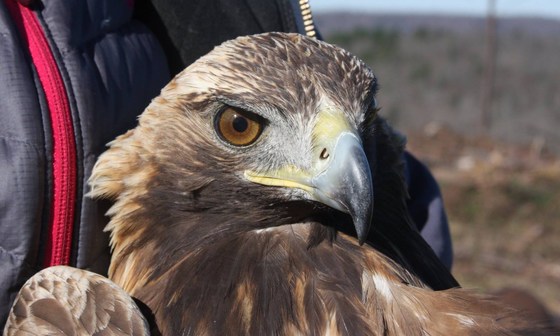 Meet Flint, the second golden eagle tracked from Georgia. (Devil's Backbone Hunting Club)
Another golden eagle from middle Georgia is providing insights into these elusive birds of prey.
The juvenile male nicknamed Flint was caught, fitted with a transmitter and released Feb. 5 at Devil’s Backbone Hunting Club near the Flint River in Meriwether and Talbot counties. An adult dubbed Devil’s Backbone was trapped at the hunting club last winter and tracked on its migration to Canada and back, a first for Georgia (“Golden find,” Feb. 25, 2015).
The birds are helping scientists document the migration routes and habitat use of eastern North America’s golden eagles. The project led by Dr. Tricia Miller of West Virginia University – and joined in Georgia by DNR's Nongame Conservation Section and the Devil’s Backbone Hunting Club – is monitoring bait-pile cameras in multiple states and tracking about 30 eagles wearing transmitters the size of small smart phones and weighing less than 2.5 ounces.
Yet one surprise for biologists and birders alike has been the number of golden eagles documented in Georgia, where they’re far less common than bald eagles. DNR senior wildlife biologist Nathan Klaus said at least five have been photographed this winter at the Devil’s Backbone club, including an eagle fitted with a transmitter last month at Talladega National Forest in Alabama.
Goldens are about the same size as bald eagles, but they scavenge less and prey more, usually on medium-sized mammals and birds, but sometimes on larger animals such as foxes and wild turkeys. They’re also more secretive. “They seem to seek out solitude.” Klaus said.
While on migration, Devil’s Backbone often appeared to avoid populated areas, he said. Most recently the eagle has been cruising the ridges and forests in and around west Georgia’s rugged Pine Mountain region.
Such behaviors suggest to Klaus a broader perspective: “That big, wild or nearly wild landscapes have conservation value because they’re big and wild.”
He thinks the Pine Mountain area has that value, and that golden eagles are “as much aware of that as we are.”
After being released, Flint left the area for a few weeks, spending time in the Fall Line sandhills. Now he’s back on the wild ridges of Pine Mountain, where he and fellow eagle Devil’s Backbone will likely spend the winter.
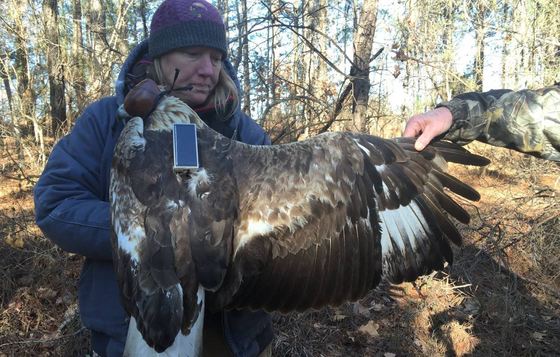 Tricia Miller checks out the bird and its transmitter. (Devil's Backbone Hunting Club)
EAGLE TRACKS
- Although the nearly real-time tracking data isn’t available to the public, Devil’s Backbone Hunting Club posts videos and photographs on Facebook. Watch the club’s Jodi Killen release Flint.
- In Georgia, the project is powered by partners, including the Devil’s Backbone club, the Nongame Conservation friends group TERN and regional staff with DNR’s Game Management Section, which helped supply dead deer as bait. Dr. Tricia Miller, her husband Michael Lanzone of Cellular Tracking Technologies (the company that makes the tracking devices) and club members trapped Flint on the third morning after two bone-chilling, daylong stakeouts.
- Three other camera traps in
Georgia, at Piedmont National Wildlife Refuge, on the Chattahoochee
National Forest near Dalton and in Baker County, also
target golden eagles as part of the project. Read this U.S. Forest Service release about a Feb. 7 sighting.
- Because poisoning from eating carrion killed by lead shot is a threat for raptors, the deer and other carcasses provided as bait are free of lead. Each trapped eagle also is tested for lead before a tracking device is attached. Flint’s results indicated he had been exposed to lead, but below the amount at which researchers would be concerned, Miller wrote.
- Golden eagles are more common west of the Mississippi River. They’re also found in Mexico, Asia, Europe and northern Africa.
Back to top.
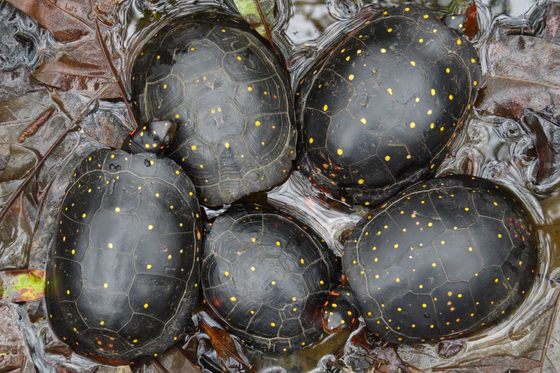 Spotted turtles. (Dirk Stevenson)
By DIRK STEVENSON
South Georgia is renowned for its impressive diversity of native turtles, from venerable landlubbers like box turtles and gopher tortoises to freshwater types like stinkpots and snappers, softshells and cooters.
But late winter to spring is the peak period of activity for what is, hands-down, one of the most beautiful and engagingly-patterned species in Georgia’s Coastal Plain – the spotted turtle. These diminutive, bluish-black turtles have small, yellowish spots on the upper shell and orange-yellow spots on the head, a striking array of spots and speckles that look like an artist painted them.
The downside to these pleasing characteristics is that they have resulted in the over-collection of spotted turtles for the pet trade, and illegal collection remains a threat. An estimated 1,000 spotted turtles are exported each year from the U.S. The species has experienced a 50-percent decline in three generations, according to the Convention on International Trade in Endangered Species of Wild Fauna and Flora, or CITES.
Also, many populations have disappeared due to habitat loss and adverse impacts to wetlands, and the spotted turtle has been petitioned for federal listing as threatened. …
Read Dirk’s blog post to learn more about spotted turtles and what you can do to help conserve one of our most poorly known species!
Dirk Stevenson is a wildlife biologist with The Orianne Society, a Georgia-based nonprofit focused on conserving amphibians and reptiles in the wild.
Back to top.
 A senior American oystercatcher -- with new bands -- and the original band. (Tim Keyes/DNR)
“Old yeller” might have a different connotation for DNR biologist and shorebird researcher Tim Keyes.
The faded, yellow leg band Keyes found on an American oystercatcher trapped and released last week at Little Sapelo Island marked the bird as originally banded at Little St. Simons Island on Jan. 16, 2001.
That means this oystercatcher is at least 16-and-a-half years old. Seventeen is senior status for the species, though end-of-life data is rare and the oldest American oystercatcher on record reached at least 23 years and 10 months.
American oystercatchers are big, orange-billed shorebirds that feed almost exclusively on oysters, clams and mussels, while also eating marine worms and other invertebrates. A species of conservation concern in the state’s Wildlife Action Plan, oystercatchers forage and nest on the Georgia coast. Nongame Conservation Section research projects vary from surveys to predator trapping that contributed to the most oystercatcher chicks documented surviving to fledging age in Georgia, more than 40 last summer. (For more on the trapping project, see "Predators vs. oystercatchers, Oct. 30, 2014.)
Keyes said details on the longevity of American oystercatchers that use the state’s coast will help conserve the birds.
“Getting better data will ultimately provide a better understanding of the demographics and better population modeling. This allows us to understand what productivity levels are needed to maintain or increase the population. It also allows us to set concrete goals for management efforts and determine if we're succeeding or not.”
Oystercatchers banded in Georgia in 2001 and 2002 were fitted with three or more color bands and a metal service band. Most of the color bands have since fallen off. While these birds are occasionally seen in the field, the only way to confirm their identity is to catch them and read the metal band code that is unique to each bird.
That’s how researchers discovered this bird was caught during the first oystercatcher trapping effort in Georgia.
AMERICAN OYSTERCATCHER FAR AFIELD
Another Georgia-tagged oystercatcher has been photographed on the Pacific Coast of Honduras, far from where scientists would expect to see it.
Of the two American oystercatcher races that breed in North America, the eastern race – along the Atlantic Coast – generally migrates no farther south than Florida’s Gulf Coast, although the “degree of migration (by population) varies with latitude … and breeding birds from South Carolina to Florida are generally non-migratory,” according to the American Oyster Working Group.
Still, the western edge of Honduras “is way, way out of where we thought they’d go,” Keyes said. Before, a Georgia-banded oystercatcher had been confirmed no farther afield than the Big Bend area of Florida.
This winter, however, four banded oystercatcher from the Atlantic breeding population have been documented in Honduras and Nicaragua. The other three birds were banded in Florida, Virginia and Massachusetts.
“There is clearly a need to understand more about the importance of Central America for our wintering oystercatchers,” Keyes said.
Back to top.
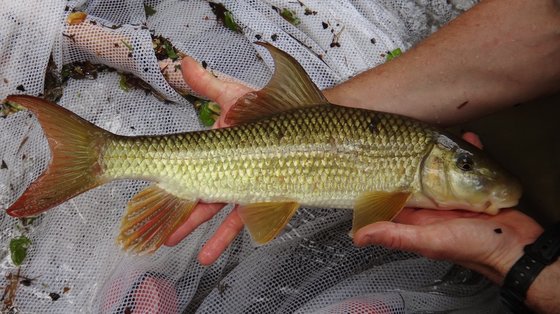 The future of sicklefin redhorse, a fish found in only six Appalachian counties worldwide, is brighter because of a Candidate Conservation Agreement signed Tuesday by power companies, the Eastern Band of Cherokee Indians and federal and state agencies, including DNR. In Georgia, the species named for its sickle-shaped dorsal fin spawns in Brasstown Creek in Towns County. (There are nine redhorse species statewide, all important as prey and indicators of stream health.) The U.S. Fish and Wildlife Service, a partner in the agreement, is weighing whether to include sicklefin redhorse on the federal endangered species list, a decision that will factor in conservation efforts expanded through this week's announcement.
Like to draw fish? The 18th annual Wildlife Forever State-Fish Art contest is open to youth in grades K-12, with a deadline of March 31. Deadlines are also drawing near for young artists who want to enter the Give Wildlife a Chance Poster Contest -- sponsored by DNR, State Botanical Garden of Georgia and The Environmental Resources Network -- and DNR's Youth Birding Competition T-shirt Art Contest.
The Berry College eagles have two eaglets – one hatched on Valentine’s Day – and pip watch has moved south to the great-horned owl nest streamed at The Landings near Savannah. In Atlanta, peregrine falcons at SunTrust Plaza Tower are exhibiting mating behaviors, with DNR’s camera ready to follow that nest.
Tallulah Gorge State Park has temporarily closed its cliffs to rock climbers in anticipation of peregrines nesting on the walls of the northeast Georgia canyon. Last year’s nest, from which two young fledged, was the first documented in the state outside of Atlanta in some 80 years ("First wild nest," May 19).
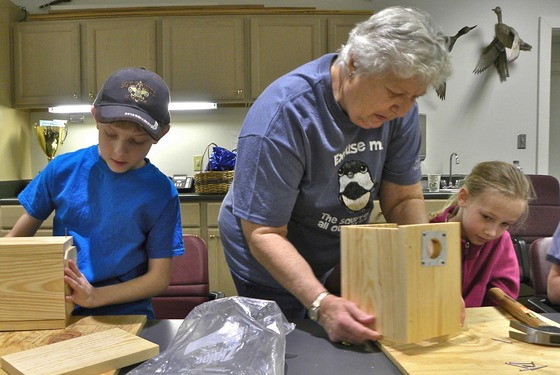 Volunteer De May helps participants in the Charlie Elliott workshop. (Linda May/DNR)
A bird-nesting basics workshop at Charlie Elliott Wildlife Center drew a flock of bird enthusiasts Saturday. The DNR Wildlife Resources Division fosters appreciation, understanding and stewardship of Georgia wildlife through such programs at Charlie Elliott and six other regional education centers across the state.
Here’s another way to follow conservation-related legislation in the Georgia General Assembly: Join the Georgia Wildlife Federation’s Camo Coalition. Options noted in the last Georgia Wild included Georgia Conservancy and the Legislature.
With leap day coming up Monday – Feb. 29 – what better time to explore Nongame Conservation Section’s work with frogs? Check out the agency’s annual report, the full version or story map overview (also featured in the ESRI story map gallery), and learn more about native frogs through the "Calls of the Wild" CD.
More than 100 people attended the fifth annual meeting of the Coastal Georgia Cooperative Invasive Species Management Area last month in Richmond Hill. The full-day symposium coordinated by Nongame Conservation staff and held with the nonprofit Coastal Wildscapes centered on pollinators, with talks varying from native bees to pollinator recovery after removing invasive species.
The Mimsie Lanier Center for Native Plant Studies at the State Botanical Garden of Georgia was dedicated Wednesday. Named for garden board member Mimsie Lanier, the center is the focal point for the Athens garden’s native plant restoration, conservation, education, production and safe-guarding work.
Athens artist Philip Juras offers a stunning portrait of undeveloped Little St. Simons Island in the new book “The Wild Treasury of Nature” (UGA Press). Juras, whose art focuses on natural landscapes and also made up “The Southern Frontier,” credits Nongame Conservation staff for helping accurately describe Little St. Simon’s natural and cultural history. Upcoming exhibitions.
Restoring working longleaf pine
and other forests in Georgia and two other states, and improving
degraded wetlands in targeted areas of this state, will draw on more than $8 million
from the U.S. Agricultural Department’s Natural Resources Conservation
Service. The agency recently said the projects, including partner
commitments that will more than double contributions, as part of its Regional Conservation Partnership Program.
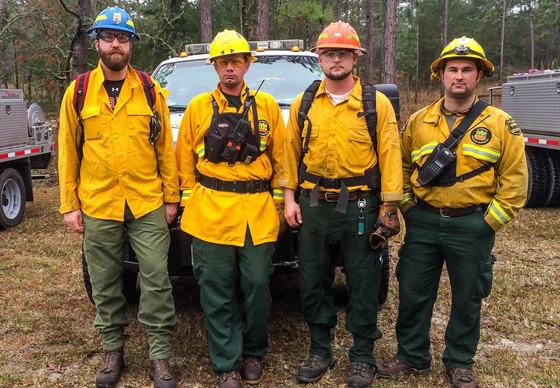 Hose race champs, from left: Jason Candeto (USFWS), Jay Tew (Fla. Forest Service), Jarrell Colter (DNR), Rowe Chase (Fla. Forest Service). (Hal Massie/DNR)
Names in the news: Add a national honor to Bobby Bond’s resume. The DNR Game Management Section wildlife biologist was presented the National Wild Turkey Federation’s Joe Kurz Wildlife Manager of the Year Award, named for the late Game Management Section Chief Joe Kurz, at the federation’s annual convention and sport show in Nashville, Tenn. DNR’s Jarrell “Trip” Colter was part of the engine crew (Engine 610, above) that won the Southern Area Engine Academy Hose Race Championship, part of wildland fire training in Florida last month. Bryn Pipes, crew leader of the DNR’s seasonal prescribed fire team in southeast Georgia, recently earned prescribed fire manager certification from the Georgia Forestry Commission. Nongame Conservation Section Assistant Chief Mary Pfaffko and botanist Dr. Mincy Moffett teamed with Jennifer Ceska, conservation coordinator of the State Botanical Garden of Georgia, this week to present a webinar on plant conservation and state wildlife action plans to Association of Fish & Wildlife Agencies members. View the presentation.
Coming up:
Through Feb. 27 – National Invasive
Species Awareness Week
Feb. 27 – 6:10 a.m., bird banding at Panola Mountain
State Park, Stockbridge. Also: 6 a.m. March 5, 6:30 a.m. March 26, 6 a.m. April
16. Georgia Important Bird Areas program coordinator Charlie Muise.
March 4-5 – Environmental Education Alliance of Georgia annual conference,
Gwinnett Environmental and Heritage Center, Buford
March 12-13 – 49th annual Claxton
Rattlesnake & Wildlife Festival, Hagan
April 22-23 – Georgia Youth
Birding Competition. Finish and banquet at Charlie Elliott Wildlife
Center, Mansfield.
May 16-18 – Longleaf Academy:
Longleaf 101 (The Longleaf Alliance), Ft. Stewart, Hinesville
Nov. 1-4 – 11th biennial Longleaf
Conference, The Longleaf Alliance, Savannah
WHAT YOU MISSED ...
in the last Georgia Wild:
- Prescribed fire season off to hot start.
- Bat rescue under a bridge.
- How to avoid bird-feeding issues in winter.
Back to top.
"Power companies, tribe, agencies take steps to save rare fish," The Chattanoogan.com. Also: Cherokee One Feather, Smoky Mountain News
"Georgia scientists get creative to protect a threatened bird," WABE-FM (90.1, Atlanta)
"Second eaglet hatches at Berry; 1st one hatched Sunday night," Rome News-Tribune
(+ video) "Ft. Stewart, other military installations part of $720M Agriculture Department projects," WTOC-TV (11, Savannah)
"USDA, partners to invest $720 million in large-scale, targeted conservation projects across the nation," USDA
"Longleaf pine conservation and restoration in Alabama gets boost with NRCS funding," The Outdoor Wire
(+ slideshow) "Firefighters burn woods at Athens nature center - to restore habitat," Athens Banner Herald
"UGA ecologist's book aims to reduce enormous wildlife toll of roadkill," Athens Banner-Herald
"Wildlife Tag Day to be held at Macon-Bibb Tax Commissioner's Office," The (Macon) Telegraph
"Announcing the world's 36th biodiversity hotspot: the North American Coastal Plain," Critical Ecosystem Partnership Fund
"Biologist earns state and national awards," Athens Banner-Herald
"Young artists invited to enter state fish art contest," The (Macon) Telegraph
"Alleged shooter of endangered whooping cranes to be prosecuted under Endangered Species Act," International Crane Foundation
(+ video) "Maryland: Joint investigation into deaths of 13 bald eagles," WMDT-TV (47, Salisbury, Maryland)
"Busting cactus smugglers in the American West," The Atlantic
"Why planting wildflowers could help feed the world," Conservation Magazine (University of Washington)
"UGA scientists to revitalize oyster population in Georgia," The Red & Black
"Arctic at risk from invasive species," Arctic Deeply
VIDEO
"Georgia painted turtle digging nest and laying eggs" in Henry County, R.K. Cook
"A sea snail that moves like a flying insect," New York Times
"Built to peck: How woodpeckers avoid brain injury," MITx Media
Back to top.
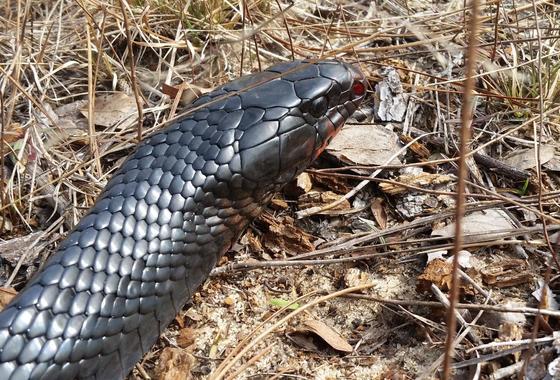 DNR’s Simon Dilts photographed this 6-foot, 8-inch eastern indigo snake recently as it slipped into a gopher tortoise burrow in south-central Georgia. Fellow employee Matthew Moore caught, PIT-tagged and released the male snake as part of a mark-recapture study of indigos, a federally threatened species (details in the Nongame Conservation Section annual report). Dilts also shot this video.
Masthead image: American bullfrog (Todd Schneider/DNR)
Back to top.
|